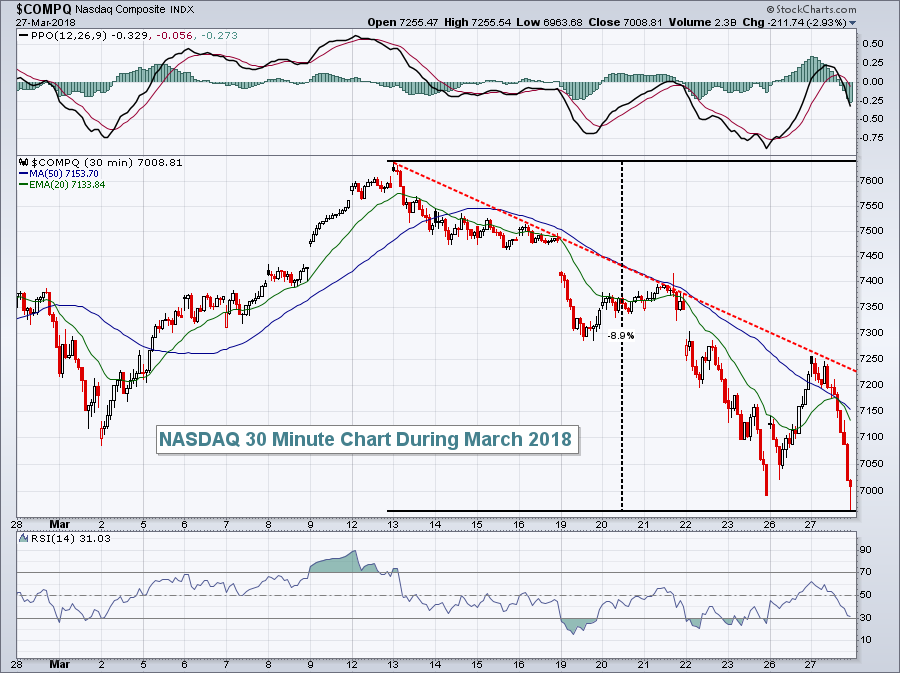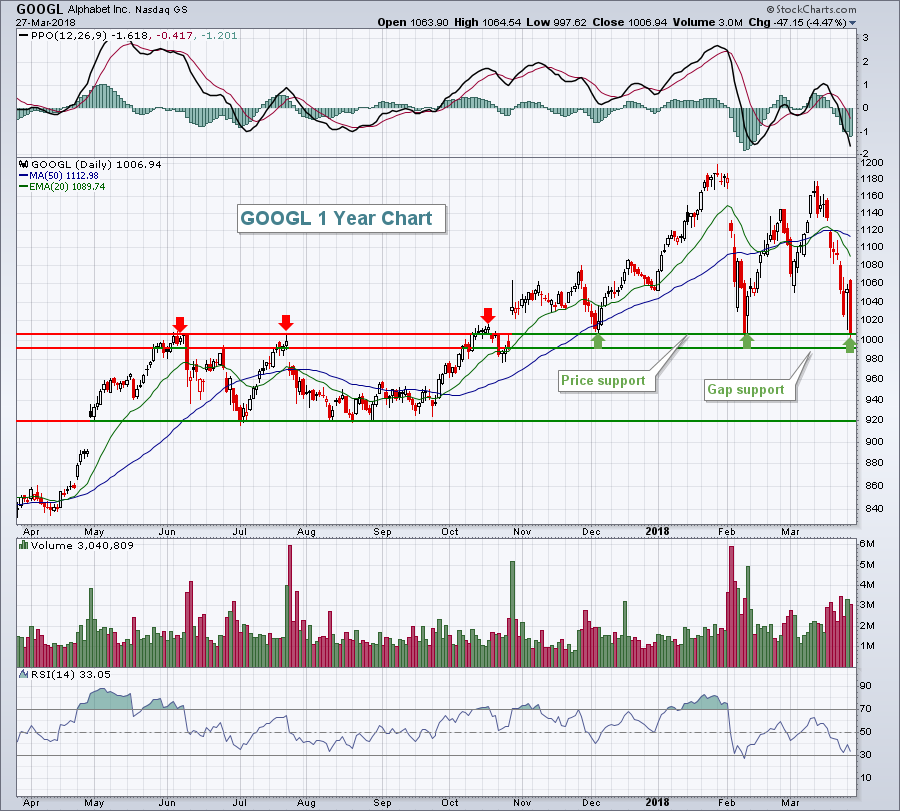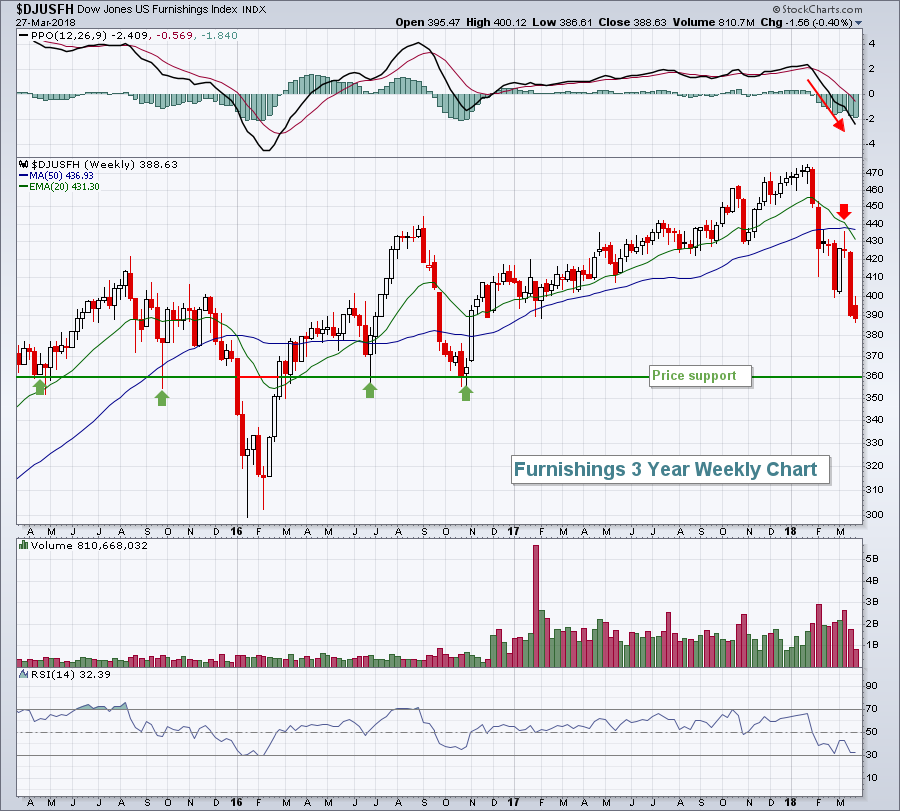Market Recap for Tuesday, March 27, 2018
I've discussed since early February the difficulty in trading a market with an elevated Volatility Index ($VIX). While returns can be awesome when you make great calls, the opposite is true when your timing is less than perfect. Here's how the NASDAQ has performed the past four trading sessions with a VIX in the 20s:
Thursday, March 22: -178.61 (-2.43%)
Friday, March 23: -174.01 (-2.43%)
Monday, March 26: +227.88 (+3.26%)
Tuesday, March 27: -211.74 (-2.93%)
Would you like to guess how many days the NASDAQ gained OR lost 2% or more in 2017? 3 times during the entire year. The difference last year is that expected volatility was nil. Below are the two 2% down days that we experienced in 2017, followed by the VIX reading the day before those losses:
May 17th: -2.57% (VIX close on May 16th was 10.65)
August 10th: -2.13% (VIX close on August 9th was 11.11)
In both instances, the market was not fearful heading into that bout of selling. Not surprisingly, the market bounced back nicely. In other words, a selloff with a fairly low VIX typically presents buying opportunities as the market is generally in a good mood. Currently, however, the VIX stands at 22.50, double those 2017 readings as the market is gripped by fear. That leads to the type of wild swings that we've been enduring since early February and adds considerable risk to short-term trading. Look at the NASDAQ's 30 minute chart for March:
 The first half of March was quite strong, but you can see that the NASDAQ had fallen nearly 9% from the March 13th intraday high to yesterday's intraday low. This market behavior/volatility is something we haven't had to deal with since 2016. You can see from the above that our selling episodes can be extremely violent with little or no support being felt along the way. Yesterday, as an example, the NASDAQ was trading in positive territory late in the morning session, then fell roughly 4% in 4 hours. Panicked selling is not rational and technical analysis, quite honestly, doesn't work very well when extreme fear is in the air. I trade using technical analysis tools and techniques so I quit trading during periods like this and await a calmer, more stable market.
The first half of March was quite strong, but you can see that the NASDAQ had fallen nearly 9% from the March 13th intraday high to yesterday's intraday low. This market behavior/volatility is something we haven't had to deal with since 2016. You can see from the above that our selling episodes can be extremely violent with little or no support being felt along the way. Yesterday, as an example, the NASDAQ was trading in positive territory late in the morning session, then fell roughly 4% in 4 hours. Panicked selling is not rational and technical analysis, quite honestly, doesn't work very well when extreme fear is in the air. I trade using technical analysis tools and techniques so I quit trading during periods like this and await a calmer, more stable market.
Of the 5 FAANG stocks, I believe Facebook (FB) is the one to completely avoid. That chart is broken and it broke on extremely heavy volume. I struggle to make bullish arguments for FB given the nature of its chart. The other 4 remain quite bullish in my view, although the current volatile environment would keep me from buying any of them as panicked selling could take all of them much lower. The most fragile appears to be Alphabet (GOOGL), which is now sitting on fairly significant price support:
 If GOOGL fails to hold 980-990 on a closing basis, we could quickly see a drop to 920. A reversal near 920 would definitely capture my attention.
If GOOGL fails to hold 980-990 on a closing basis, we could quickly see a drop to 920. A reversal near 920 would definitely capture my attention.
Pre-Market Action
The 10 year treasury yield ($TNX) closed beneath 2.80% support yesterday, a short-term blow to equities as it reflects more nervousness and a shift towards defensive bonds. The TNX is slightly lower this morning to 2.77% and that's a warning sign for equities, particularly financial stocks. Gold ($GOLD) and crude oil ($WTIC) are both down fractionally this morning.
Renewed global selling is not helping, although Dow Jones futures are set to open slightly higher in 40 minutes. Dow futures are up 83 points, but NASDAQ futures suggest yesterday's selloff may continue into the open today. NASDAQ futures are down 13 points at last check.
Current Outlook
The Dow Jones daily chart is quite bearish, suggesting we haven't seen the end of the selling. The daily PPO, after approaching centerline resistance twice, has turned down in a big way and set fresh new lows, with price action failing to clear the declining 20 day EMA. That's poor technical action and needs to be respected in the very near-term:
 The near-term is very dicey and extremely risky. There's no getting around that. But the intermediate- to long-term pattern remains very bullish in my view. I continue to believe that short-term selling will provide opportunities for entry into a long-term bull market. The "under the surface" signals are bullish. Money has not rotated towards defense as it normally does before the start of a bear market. Therefore, current selling appears to be of a corrective nature. While that might feel soothing to a longer-term investor, the short-term risks are REAL to a swing trader. Unfortunately, these are the cards we've been dealt so it'll likely take some additional patience to weather this market storm.
The near-term is very dicey and extremely risky. There's no getting around that. But the intermediate- to long-term pattern remains very bullish in my view. I continue to believe that short-term selling will provide opportunities for entry into a long-term bull market. The "under the surface" signals are bullish. Money has not rotated towards defense as it normally does before the start of a bear market. Therefore, current selling appears to be of a corrective nature. While that might feel soothing to a longer-term investor, the short-term risks are REAL to a swing trader. Unfortunately, these are the cards we've been dealt so it'll likely take some additional patience to weather this market storm.
Sector/Industry Watch
The Dow Jones U.S. Furnishings Index ($DJUSFH) has fallen roughly 7.5% over the past week, easily the worst performing industry group within consumer discretionary. It's now made multi-month lows and looks poised to make a run at its October 2016 low:
 Should the selling continue, the reward to risk really begins to improve at 360 as we've seen plenty of kick saves at that price level. I wouldn't expect to see that much more selling, but panicked selling does crazy things so it's not out of the question.
Should the selling continue, the reward to risk really begins to improve at 360 as we've seen plenty of kick saves at that price level. I wouldn't expect to see that much more selling, but panicked selling does crazy things so it's not out of the question.
Historical Tendencies
Of the 5 FAANG stocks, here are the average historical returns of each for both April and May:
Facebook (FB) - over last 7 years: +2.5% (April) and -4.4% (May)
Apple (AAPL) - over last 20 years: +4.5% and +1.6%
Amazon.com (AMZN) - over last 20 years: +8.8% and +2.1%
Netflix (NFLX) - over last 17 years: +1.4% and +5.9%
Alphabet (GOOGL) - over last 15 years: +4.3% and +2.9%
Key Earnings Reports
(actual vs. estimate):
BB: .05 vs .00
WBA: 1.73 vs 1.15
(reports after close, estimate provided):
PVH: 1.48
Key Economic Reports
Final Q4 GDP released at 8:30am EST: +2.9% (actual) vs. +2.7% (estimate)
February pending home sales to be released at 10:00am EST: +3.0% (estimate)
Happy trading!
Tom






